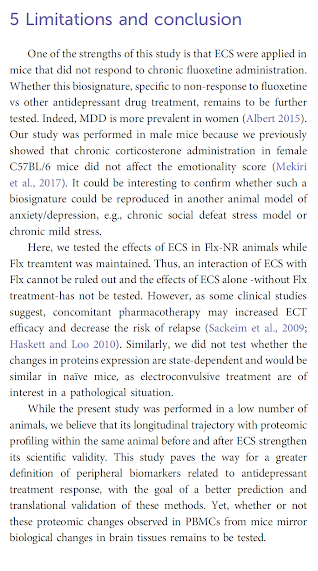Peripheral Proteomic Changes After ECS in Mice With "TRD", New Study From France
Out on PubMed, from researchers in France, is this study:
Peripheral proteomic changes after electroconvulsive seizures in a rodent model of non-response to chronic fluoxetine.
Front Pharmacol. 2022 Oct 31;13:993449. doi: 10.3389/fphar.2022.993449. eCollection 2022.PMID: 36386166
The abstract is copied below:
Major depressive disorder (MDD) is the psychiatric disorder with the highest prevalence in the world. Pharmacological antidepressant treatment (AD), such as selective serotonin reuptake inhibitors [SSRI, i.e., fluoxetine (Flx)] is the first line of treatment for MDD. Despite its efficacy, lack of AD response occurs in numerous patients characterizing Difficult-to-treat Depression. ElectroConvulsive Therapy (ECT) is a highly effective treatment inducing rapid improvement in depressive symptoms and high remission rates of ∼50-63% in patients with pharmaco-resistant depression. Nevertheless, the need to develop reliable treatment response predictors to guide personalized AD strategies and supplement clinical observation is becoming a pressing clinical objective. Here, we propose to establish a proteomic peripheral biomarkers signature of ECT response in an anxio/depressive animal model of non-response to AD. Using an emotionality score based on the analysis complementary behavioral tests of anxiety/depression (Elevated Plus Maze, Novelty Suppressed Feeding, Splash Test), we showed that a 4-week corticosterone treatment (35 μg/ml, Cort model) in C57BL/6JRj male mice induced an anxiety/depressive-like behavior. A 28-day chronic fluoxetine treatment (Flx, 18 mg/kg/day) reduced corticosterone-induced increase in emotional behavior. A 50% decrease in emotionality score threshold before and after Flx, was used to separate Flx-responding mice (Flx-R, n = 18), or Flx non-responder mice (Flx-NR, n = 7). Then, Flx-NR mice received seven sessions of electroconvulsive seizure (ECS, equivalent to ECT in humans) and blood was collected before and after ECS treatment. Chronic ECS normalized the elevated emotionality observed in Flx-NR mice. Then, proteins were extracted from peripheral blood mononuclear cells (PBMCs) and isolated for proteomic analysis using a high-resolution MS Orbitrap. Data are available via ProteomeXchange with identifier PXD037392. The proteomic analysis revealed a signature of 33 peripheral proteins associated with response to ECS (7 down and 26 upregulated). These proteins were previously associated with mental disorders and involved in regulating pathways which participate to the depressive disorder etiology.
Keywords: difficult to treat depression; electroconvulsive therapy; fluoxetine; major depressive disorder; non-response; peripheral biomarkers.
The pdf is here.
And from the text:
Here's a very interesting pre-clinical study: mice were rendered depressed by cortiscosterone, treated with fluoxetine, and non-responders to fluoxetine were given ECS.
The peripheral blood proteomic signature of these now-successfully treated "TRD" mice was examined. This "biosignature" may be a clue to the mechanism of action of ECT or help predict treatment response.
The paper is well-presented and worth a full read, ~20 minutes.






Comments
Post a Comment